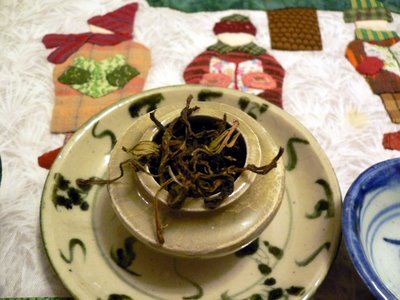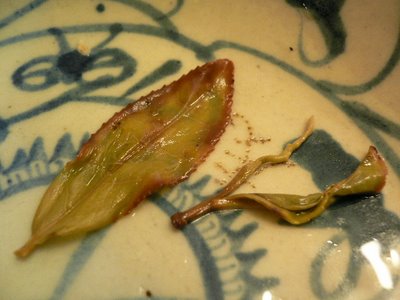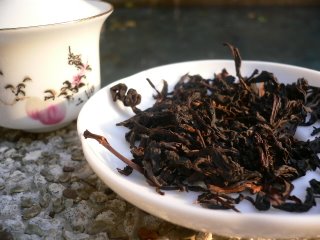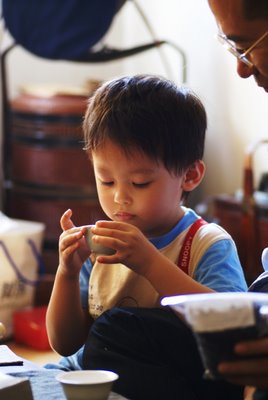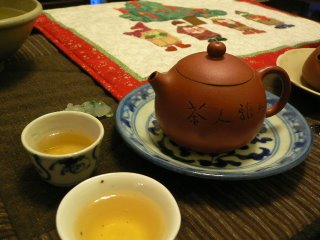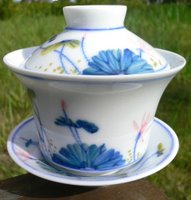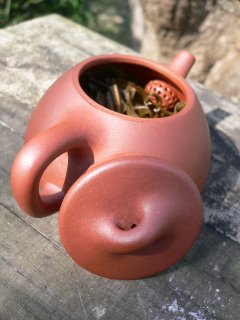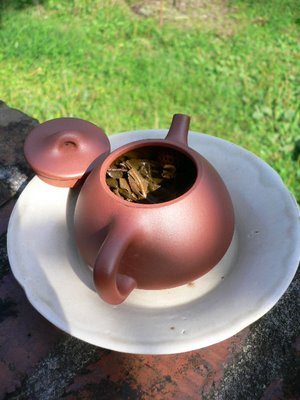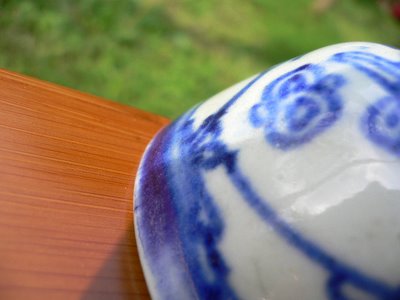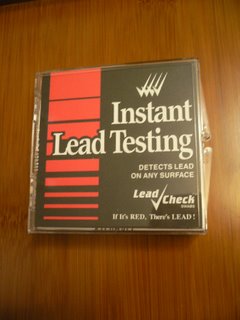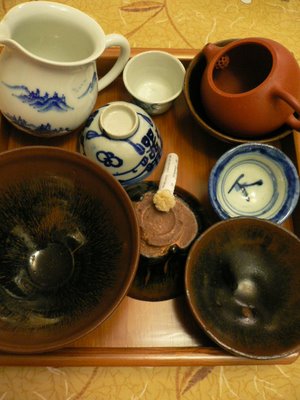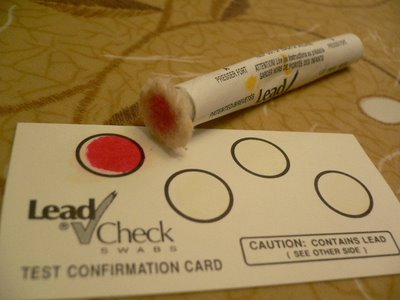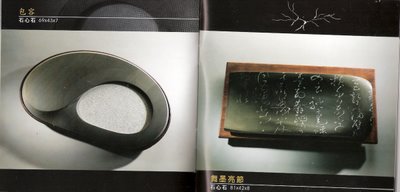
These 2 big bags of tea show the WenShan teas I have purchased 2 days ago in Pinglin. The bag on the right contains 48 bags of 'lily flower' Baozhong, a very good, decently priced, low oxidized Fall Baozhong. The other bag contains a mix of top quality, very fresh Baozhongs, a 'Monkey Hair' Oriental Beauty and some Fo Shou Oolong. All in all, 18.6 kg!
Driving home, I felt a great sense of satisfaction and excitment. The day had gone very well. It almost felt like graduation or the completion of the last, tough level in the 'Lord of the Rings' video game.
I've already told the story in French, but have been asked for a translation. I think you may also learn something from it, and so let me also tell you how I 'graduated'.
My first 'task' was to select my light oxidized 'lily flower' Baozhong between these 2 Baozhongs (end of September harvest):

I chose the one on the left, because the fragrance was nicer and more persistant. Also, the leaves had a lighter color, better fitting the light oxidation. The farmer agreed this was the better choice. (For reference, we used 4 grams for 5 minutes brewing).

In the second 'task', I had to select my first quality stronger oxidized 'Subtropical Forest' Baozhong (November harvest). Again, I had 2 Baozhongs to select from. Here, the difference was much more clearcut. The one on the left was not oxidized enough for what I'm searching. Also, despite costing twice as much as the 'lily flower' I had selected, it was just maybe 25% better.
The glass on the right is actually from the same field as the Spring version. But this time, this harvest is going to participate in an upcoming tea competition. Usually, this harvest would not be for sale until after the competition. Should it win a prize, it could be sold for a higher price.
I insisted on having from this one, because the length and the traditional taste of fresh Baozhong were there. Also, typical for the winter harvest, the aftertaste turned from a short sour note to a sweet one. This aftertaste was also longer than for the Spring version (Spring is usually more fragrant). The farmer then agreed to sell me from this lot at the regular price and not wait for the competition to take place. I felt lucky in my timing and happy to buy this very good tea.
While the farmer left his house to go and bring back more tea, I tried some of his most expensive Oriental Beauty: Mao Ho (Monkey Hair) from Summer 2005. The leaves are bigger than usual. He later told me that this is Oriental Beauty is made with another, more ancient tea varietal than what is commonly used now (luanze oolong and qingxin DaPa). It showed promise and I will further compare it at home with 2 other Oriental Beauties (stay tuned!)
On this level, it felt like discovering a hidden treasure behind the counter (to continue the video game analogy.)
When the farmer came back, I used a first 'magic spell': I proposed to share some of the Wu Yi Yan Cha I had received from Teaparker last Sunday. He chose the Bai Ji Guan and was immediately impressed by the strong fragrance coming out of my tea box (the zip of the tea bag was still closed). It had been a while since he hadn't drunk Bai Ji Guan and was very happy with this tea cup. He also quickly filled a cup for his wife (a loving huband shares only the good stuff!)
The magic performed wonderfully well: the tea farmer was moved and decided to share with me in return his 2nd place Baozhong at the last tea competition. Hummmm. A very fine and pure low oxidized Baozhong. He then asked me to brew the second Yan Cha I had with me: the 2003 Rou Guei. This time he was practically dancing! "Excellent roasting! Wharf! That's a good tea!" he said with a voice refilled with energy. His wife got here cup filled too and agreed.
This time he proposed to brew a semi-wild Baozhong from this November too. This one comes from a plantation that is left wild, without fertilizer or pesticides. Such leaves grow bigger and are sometimes bitten by insects. The result is a more oxidized, very concentrated and fragrant Baozhong (close to the 'subtropical forest'). It has a typical 'wild' note in terms of smell. But, most importantly, like all wild teas (for instance puerh), the taste is fuller in the mouth (on the top of the mouth).
And the best of all, is that this farmer let me purchase these 2 teas! The excellent Yan Cha teas have given me access to the treasure trove! (These 2 Baozhongs -2nd place and semi-wild Baozhong- are expensive, though, and so I reduce the quantity to 75 gr for the same price as 150 gr of top quality Subtropical Forest Baozhong.)
Sharing excellent tea with somebody who loves and understands tea is always an interesting experience. Showing your understanding of tea is also important to gain the respect of your supplier. Friday, I was able to combine both and it made me feel very happy all evening long.
Teaparker often told us that it's not with money that you get the best tea from a Chinese or Taiwanese tea farmer. My experience is a good illustration.
 The flowers are so strong and big that they can hold my Baotai zhuni Shui Ping teapot:
The flowers are so strong and big that they can hold my Baotai zhuni Shui Ping teapot:  (Don't try this stunt at home. We decline responsibility for any loss or consequential damages.)
(Don't try this stunt at home. We decline responsibility for any loss or consequential damages.) Speaking of scents, Eitan, a reader in Seattle wrote me that: "I own a zisha pitcher (not a teapot) that I too often leave overnight with it's lid on when there is still moisture inside. Because of this there is a faint mildew smell in it, and I am afraid it affects the tea's smell and taste. Is there any way to get rid of this smell?"
Speaking of scents, Eitan, a reader in Seattle wrote me that: "I own a zisha pitcher (not a teapot) that I too often leave overnight with it's lid on when there is still moisture inside. Because of this there is a faint mildew smell in it, and I am afraid it affects the tea's smell and taste. Is there any way to get rid of this smell?"
